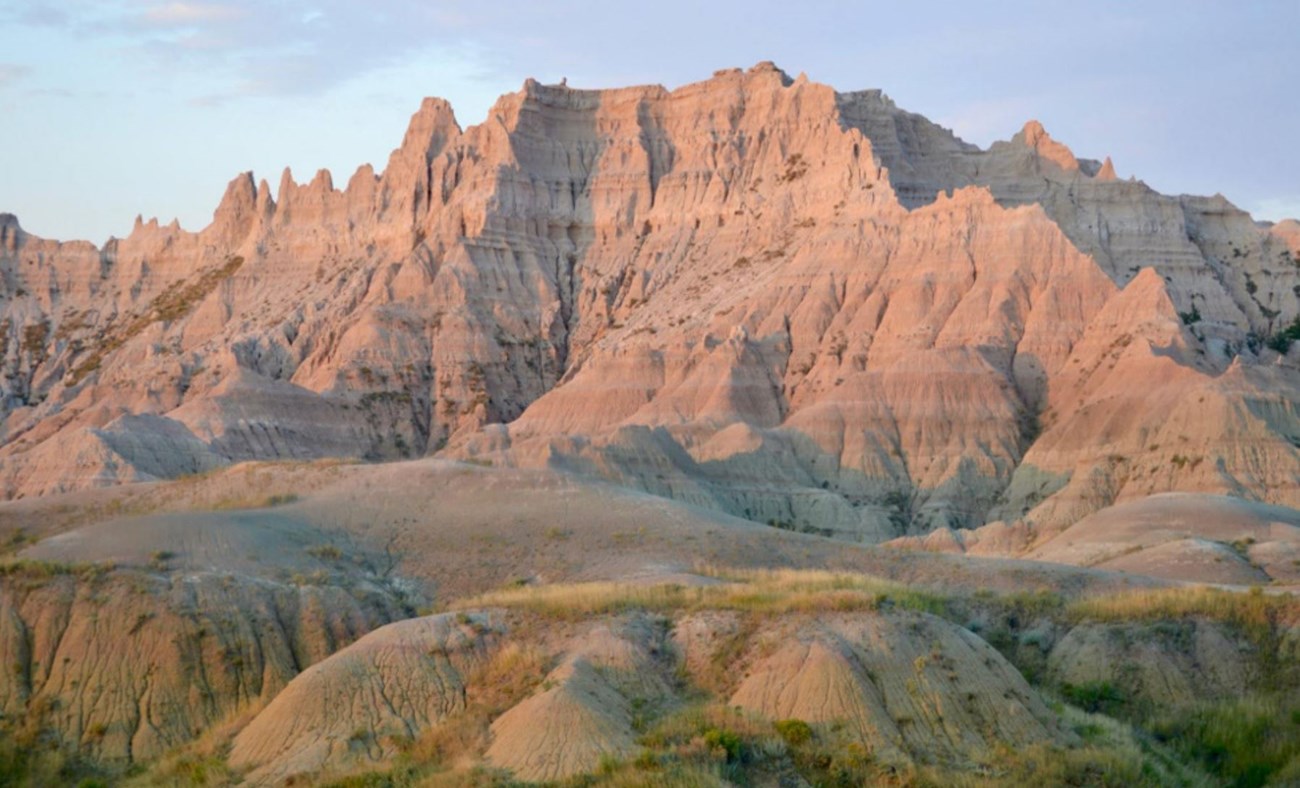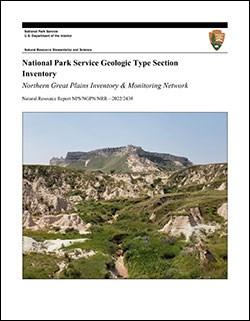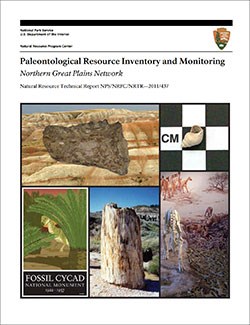
NPS photo by Ed Walsh
Geology and Stratigraphy of the Northern Great Plains I&M Network Parks
The Northern Great Plains Inventory and Monitoring Network consists of 13 national park units in portions of Montana, Nebraska, North Dakota, South Dakota, and Wyoming. The park units of the Northern Great Plains Network include Agate Fossil Beds National Monument, Badlands National Park, Devils Tower National Monument, Fort Laramie National Historic Site, Fort Union Trading Post National Historic Site, Jewel Cave National Monument, Knife River Indian Villages National Historic Site, Missouri National Recreational River, Mount Rushmore National Memorial, Niobrara National Scenic River, Scotts Bluff National Monument, Theodore Roosevelt National Park, and Wind Cave National Park. Together, the parks that comprise the Northern Great Plains Network protect a combined 177,100 hectares (437,700 acres) of land and vary in size from 178 hectares (440 acres) in Fort Union Trading Post to 98,239 hectares (242,756 acres) in Badlands.
The rich geologic history of the Northern Great Plains Network dates back more than a billion years, recording the growth of ancestral North America, the rise of the Rocky Mountains, shallow continental seaways, and Pleistocene glaciations. Some of the oldest rocks underlying the park units of the Northern Great Plains Network are Paleoproterozoic crystalline rocks in Mount Rushmore and Wind Cave that form the core of the Black Hills of South Dakota and Wyoming. These metamorphic and igneous rocks include the Harney Peak Granite, used as the in situ medium for the colossal sculpted busts of U.S. Presidents Washington, Jefferson, Roosevelt, and Lincoln at Mount Rushmore. The Harney Peak Granite was emplaced as a series of sills and dikes during an ancient tectonic collisional event known as the Trans-Hudson Orogeny that occurred approximately 1.7 billion years ago (Nabelek et al. 1999; Sirbescu and Nabelek 2003).
Following the Trans-Hudson Orogeny, the geologic record in the Northern Great Plains Network only provides episodic glimpses into the past until the late Cambrian Period, approximately 495 million years ago. The diverse Paleozoic and Mesozoic bedrock underlying the park units of the Northern Great Plains Network spans from the late Cambrian through the Cretaceous, providing a richer but still incomplete view of the evolution of North America. These bedrock strata were deposited during a series of marine transgressions (sea-level rise) and regressions (sea-level fall) associated with shallow, tropical continental seaways such as the Sundance Sea and Western Interior Seaway. The Mississippian Pahasapa Limestone was deposited in this kind of marine setting and is the predominant bedrock hosting the vast cave resources of Jewel Cave and Wind Cave. During the Late Cretaceous and Paleogene, approximately 80 to 50 million years ago, the Laramide Orogeny would elevate the Northern Great Plains and uplift the Rocky Mountains and the Black Hills region (Lisenbee 1988; Lisenbee and DeWitt 1993; Sirbescu and Nabelek 2003). The Black Hills contain several Northern Great Plains Network park units (Badlands, Devils Tower, Jewel Cave, Wind Cave) and represents an exposed basement uplift or arch that displays a central core of Precambrian crystalline rocks flanked by concentric ridges and valleys underlain by much younger Paleozoic and Mesozoic sedimentary strata (Keefer 1974; Lisenbee 1988).
At the beginning of the Cenozoic Era, the last remnants of the Western Interior Seaway retreated from the Northern Great Plains as highlands to the west continued to rise. Igneous activity associated with the continuation of the Laramide Orogeny produced several igneous intrusions including what is now Devils Tower at Devils Tower National Monument. Vast amounts of sediment were shed from the young Rocky Mountains and distributed as large wedges and sheets of clastic material across the central Great Plains region; many of these sediments contain the renowned fossiliferous strata of the Eocene–Oligocene White River Group (Badlands, Scotts Bluff, Wind Cave), Arikaree Group (Agate Fossil Beds, Badlands, Fort Laramie, Niobrara National Scenic River, Scotts Bluff), and Ogallala Group (Agate Fossil Beds, Niobrara National Scenic River). Volcanism in the Western Cordilleran region (Great Basin and Rocky Mountain areas) occurred from the Oligocene through Miocene and introduced thick blankets of pyroclastic material that are associated with the White River Group and overlying Sharps Formation. Rivers draining the high plains east of the Black Hills dissected the region of Badlands, exposing the iconic layer-cake stratigraphy of the park and sculpting the namesake badlands topographic landscape (Stoffer 2003). The Quaternary history of the Northern Great Plains Network includes a period of glacial advances and retreats that are recorded by only a few park units (Fort Union Trading Post, Knife River Indian Villages, Missouri National Recreational River, and Theodore Roosevelt National Park). A diverse assemblage of Quaternary deposits mapped throughout the Northern Great Plains Network are associated with fluvial landscapes associated with the Missouri River (Fort Union Trading Post, Knife River Indian Villages, Missouri National Recreational River), Niobrara River (Agate Fossil Beds, Missouri National Recreational River, Niobrara National Scenic River), North Platte River (Fort Laramie, Scotts Bluff), Belle Fourche River (Devils Tower), Knife River (Knife River Indian Villages), and Little Missouri River (Theodore Roosevelt National Park).
A Brief Geologic History
A few examples of events and Network resources in each geologic time period are highlighted below, from youngest to oldest.
A wide variety of young, Quaternary surficial deposits has been mapped across the parks of the Northern Great Plains Network and includes glacial outwash and till (Fort Union Trading Post, Knife River Indian Villages, Missouri National
Recreational River, Theodore Roosevelt), terrace deposits (Agate Fossil Beds, Devils Tower, Missouri National Recreational River, Wind Cave), aeolian sand and loess (Badlands, Fort Laramie, Missouri National Recreational River, Scotts Bluff), alluvial deposits (Mount Rushmore, Theodore Roosevelt National Park, Wind Cave), landslide deposits (Badlands, Theodore Roosevelt National Park, Wind Cave), rockfall deposits (Devils Tower, Mount Rushmore, Scotts Bluff), alluvium (Agate Fossil Beds, Badlands, Devils Tower, Fort Laramie, Fort Union Trading Post, Jewel Cave, Missouri National Recreational River, Niobrara, Scotts Bluff, Theodore Roosevelt National Park), and colluvium (Agate Fossil Beds, Fort Union Trading Post, Missouri National Recreational River, Scotts Bluff).
Geology & Soils—Northern Great Plains Network Parks
Type Sections—Northern Great Plains Network

The geologic history above is excerpted from a report titled, "National Park Service geologic type section inventory: Northern Great Plains Inventory & Monitoring Network". Type sections are essential reference locations for the geoscientists who study geologic history and paleontology. A summary of the type sections in each park can be found at the links below.
-
Agate Fossil Beds National Monument, Nebraska (contains one identified stratotype)
-
Badlands National Park, South Dakota (contains six identified stratotypes)
-
Devils Tower National Monument, Wyoming (no designated stratotypes identified)
-
Fort Laramie National Historic Site, Wyoming (no designated stratotypes identified)
-
Fort Union Trading Post National Historic Site, North Dakota and Montana (no designated stratotypes identified)
-
Jewel Cave National Monument, South Dakota (no designated stratotypes identified)
-
Knife River Indian Villages National Historic Site, North Dakota (no designated stratotypes identified)
-
Missouri National Recreational River, South Dakota and Nebraska (contains one identified stratotype)
-
Mount Rushmore National Memorial, South Dakota (no designated stratotypes identified)
-
Niobrara National Scenic River, Nebraska (contains four identified stratotypes)
-
Scotts Bluff National Monument, Nebraska (contains one identified stratotype)
-
Theodore Roosevelt National Park, North Dakota (no designated stratotypes identified)
-
Wind Cave National Park, South Dakota (no designated stratotypes identified)
The full Network report is available in digital format from:
Please cite this publication as:
- Henderson TC, Santucci VL, Connors T, Tweet JS. 2022. National Park Service geologic type section inventory: Northern Great Plains Inventory & Monitoring Network. Natural Resource Report. NPS/NGPN/NRR—2022/2439. National Park Service. Fort Collins, Colorado.
NPS Stratotype Inventory
Fossil Resources—Northern Great Plains

Between 2002 and 2011, network-based paleontological resource inventories were completed for all the 32 I&M networks, and six of the earliest were completely updated between 2012 and 2016. The report linked below summarizes the paleontological resources of all park units in the Northern Great Plains Inventory & Monitoring Network (NGPN). The report provides geologic background and paleontological resource data for each park to support management operations, planning, and science-based decision making as required by NPS management policies and the Paleontological Resources Preservation Act (2009).
The full report is available in digital format from
-
DataStore - Paleontological resource inventory and monitoring: Northern Great Plains Network (nps.gov)
Please cite this publication as:
-
Tweet, J. S., V. L. Santucci, and J. P. Kenworthy. 2011. Paleontological resource inventory and monitoring: Northern Great Plains Network. Natural Resource Technical Report NPS/NRPC/NRTR—2011/437. National Park Service, Fort Collins, Colorado.
Geodiversity Atlas pages—by Inventory & Monitoring Network
Arctic Network Index
Central Alaska Network Index
Chihuahuan Desert Network Index
Cumberland Piedmont Network Index
Eastern Rivers and Mountains Network Index
Great Lakes Network Index
Greater Yellowstone Network Index
Gulf Coast Network Index
Heartland Network Index
Klamath Network Index
Mediterranean Coast Network Index
Mid-Atlantic Network Index
Mojave Desert Network Index
National Capital Network Index
North Coast and Cascades Network Index
Northeast Coastal and Barrier Network Index
Northeast Temperate Network Index
Northern Colorado Plateau Network Index
Northern Great Plains Network Index
Pacific Islands Network Index
Rocky Mountain Network Index
San Francisco Bay Area Network Index
Sierra Nevada Network Index
Sonoran Desert Network Index
South Florida/Caribbean Network Index
Southeast Alaska Network Index
Southeast Coast Network Index
Southern Colorado Plateau Network Index
Southern Plains Network Index
Southwest Alaska Network Index
Upper Columbia Basin Network Index
Geodiversity Atlas pages—by State, U.S. Commonwealth, and Territories
Alabama | Alaska | Arizona | Arkansas | California | Colorado | Connecticut | District of Columbia | Delaware | Florida | Georgia | Hawaii | Idaho | Illinois | Indiana | Iowa | Kansas | Kentucky | Louisiana | Maine | Maryland | Massachusetts | Michigan | Minnesota | Mississippi | Missouri | Montana | Nebraska | Nevada | New Hampshire | New Jersey | New Mexico | New York | North Carolina | North Dakota | Ohio | Oklahoma | Oregon | Pennsylvania | Rhode Island | South Carolina | South Dakota | Tennessee | Texas | Utah | Vermont | Virginia | Washington | West Virginia | Wisconsin | Wyoming
U.S. Commonwealth and Territories
Region 2: South Atlantic-Gulf (Includes Puerto Rico and the U.S. Virgin Islands)
Region 3: Great Lakes
Region 4: Mississippi Basin
Region 5: Missouri Basin
Region 6: Arkansas-Rio Grande-Texas-Gulf
Region 7: Upper Colorado Basin
Region 8: Lower Colorado Basin
Region 9: Columbia-Pacific Northwest
Region 10: California-Great Basin
Region 11: Alaska
Region 12: Pacific Islands (American Samoa, Hawaii. Guam, Commonwealth of the Northern Mariana Islands)
Last updated: February 21, 2025
